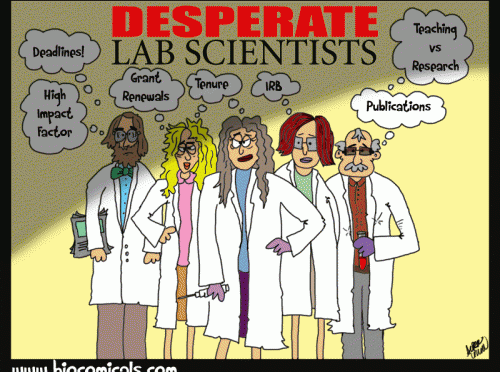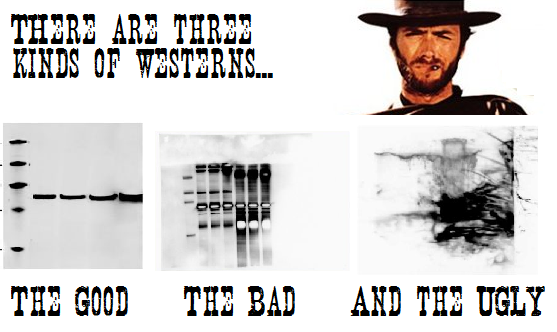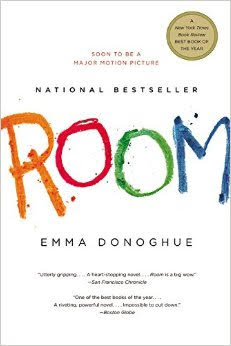Guest Post by Ania Wronski, PhD.
- Write everything down
Whether you are learning a technique from someone or you are running you thousandth PCR reaction, if you do something different or noteworthy – write it down. I assure you, when months down the line you need to repeat a similar reaction (and you will!) you will NOT remember the conditions that you thought were so obvious that you didn’t write it down. Even details that may not seem very significant – like, I had a longer lunch so my blot was in blocking solution for 2 hours instead of one, may make a big different to the end result and knowing why may vastly improve your reproduction of the results.
- Be organized
When you start a project, identify a storage structure and STICK TO IT. This sounds relatively simple, but it isn’t! Are you going to organize your scientific literature by topic? What if it covers multiple topics? What filename will you use to save it? How are you going to organize your data? By experimental type? Date? Project? You want to be able to find things relatively easily and NOT have multiple copies of the same or similar files floating around.
Same goes for labelling tubes. Please, for the love of the PCR fairy, please DO NOT label your tubes 1-8. At least put the date and some redeeming feature. One of the best things to do is to log it in a database with its details and location so you have the capacity to search for it electronically – but it does take time to establish these systems and it is often MUCH harder to go back and re-organize your samples once you have 4 boxes of plasmids and several boxes of primers…
- Be consistent
Science is already hard – why make life harder for yourself? When you get in stock solutions, make them to a nice, repeatable number. Dilute primers to 50 or 100uM every time you get a new primer tube. That way, you don’t need to look up what you did. It is a standard dilution for all your primers. This also leads to better science as consistency is often the best way to reduce variability and increase the reproduction of results. Passage cells a certain way? Why deviate? You could be introducing variability that may influence your downstream applications.
- Re write protocols for a dummies guide.
You could be a cloning god or goddess, but what happens when you don’t have to do a technique for an extended period of time? You forget. Re-write your protocols so they explain all the steps, including the little quirks that you discovered are the keys to success. This is especially important for logins to shared equipment that you may not access very frequently (I.e. the nanodrop password on level 5 is DropitLikeItsHot). I often write several versions of protocols: a lengthy “extended” protocol with explanations and detailed information and a short “mini” protocol that I can just fill out the blanks as I need for the experiment. One warning about having spreadsheet protocols: you can accidentally introduce errors and not even realize it! So it’s always good to check your spreadsheet or have some “control” calculations that will let you know if something is wrong.
- Make sure you use the appropriate controls!
If an experiment fails, controls can help you determine if it was a technical failure or a negative result (same with the inverse – a positive result or a technical glitch). Many may think that controls are a waste of time and reagents, however controls are more important than your experimental sample because it tells you if your result can be trusted. You are only as good as your positive and negative controls!
- Understand your techniques
Nowadays there is a kit for everything technique conceivable – the age of convenience has hit the world of scientific research. Although kits can make your experiments much easier, they are also a very easy way to become complacent. If you don’t know how an experiment actually works, you won’t know the limitations of your results and the conclusions you can or cannot draw from them. In addition, troubleshooting is MUCH easier if you understand the rationale behind how an experiment works.
- Never stop learning
The vast majority of scientists has an innate desire for knowledge – it’s why we are scientists to begin with! You can learn something from everybody, from the new grad student to the seasoned postdoc. This includes the lab down the hall working on a random organism that doesn’t seem related. Some of the greatest discoveries in science came about when multiple fields crossed paths. Never turn down an opportunity to learn, as your knowledge is your best asset as a scientist.
- Ask for helpEveryone is always busy so it can seem daunting to ask someone with a full plate for help. However, you are surrounded by incredibly skilled and intelligent individuals. If you do not ask, you cannot ever receive. When you do ask, try to be mindful of their time, maybe even email them to ask for a good time to sit down and chat with them. Know what you want to ask and make sure it’s not an answer that can be relatively easily answered by google or a lab protocol that is easily accessed. Much of the knowledge of science is passed down from lab member to lab member.
- Don’t think about the how, think about the WHY
When you are the bench, it is very easy to fall into a pattern of simply doing experiments because that feels comfortable. A great scientist will consider why they are doing an experiment. Before you rush into anything new, sit down and consider all of your data. What is it telling you? What would the next logical step be? What question are you really asking? What is the big picture? It is pointless to mindless conduct experiments if they will not help further your question and the eventual result. Even if you know it is highly unlikely that you will achieve your end goal, you should still one in mind.
- Be prepared for change.
Two years ago, CRISPR sounded like a type of cracker, nowadays it’s the hot new technique. Science is dynamic and is constantly changing. You need to be prepared for these and be amendable to changes, whether it be new techniques, a change in direction or even location. If you are working in industry, it is common for projects to suddenly be terminated or drastically change, even if everything is going well. In academia, we are not as efficient at culling projects and tend to beat the proverbial dead research horse because we really want a project to work out. One critical skill of a researcher is to know when they have hit a dead end and to move on. It is extremely difficult and you often need to convince powerful people (i.e. your PI) that it’s the right decision.
Originally published on AdageOfAnia.com
Ania is a post-doctoral fellow in the Kupperwasser lab and blogs regularly about “Science!” at www.adageofania.com











